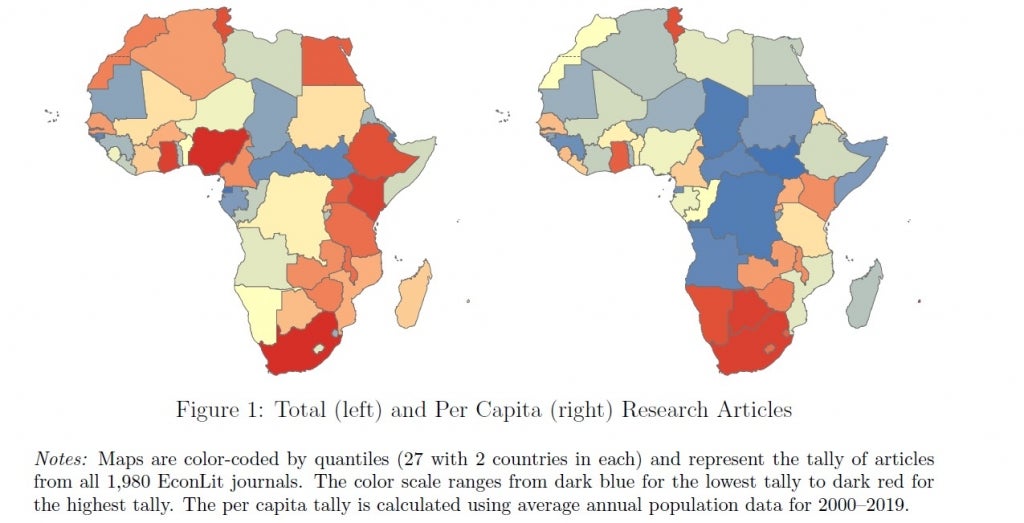As I was returning from my summer break, I stumbled across an interesting new paper by Obie Porteous. Porteous has put in a tremendous amount of work to classify over 27,000 articles on Africa to look at how things are distributed.
Let’s start with a couple of interesting stats.
First, the number of articles about Africa per decade has been growing over time – from 911 from 1970-79 to 19,242 in 2010-19. And sure, there are more journals than there used to be, but the share of articles has also jumped from 0.01 to around 0.04 (I leave you to draw your own conclusion about the 0.04).
Second, Porteous quickly points out some serious concentration, with five countries showing some serious concentration: 65% of all top five journal articles on Africa from 2000-2019 and 45% of articles in all economics journals. Want to guess what those five are?
The “frequent five” are Kenya, South Africa, Ghana, Uganda, and Malawi. He contrasts these with the “scarce seven” – Sudan, D.R. Congo, Angola, Somalia, Guinea, Chad, and South Sudan, which have roughly the same population and account for only 3.5 percent of all economics journal articles and 4.7 percent of articles on Africa in the top 5. Indeed, Kenya and DRC are interesting contrasts, with 36 articles on Kenya in the top 5 over the last 20 years, but only 5 on DRC. This carries through to more broad rankings – for the top 10 development journals, Kenya has 211 articles over the same period, and the DRC has….15. (And then there are Comoros and Equatorial Guinea – these aren’t even among EconLit’s geographical descriptors (and so Porteous has to classify them by hand)).
Third, Porteous has an interesting table of which journals publish the most articles on Africa during the 2000-19 period. Any guesses as to the number 1?
Topping the list is World Development. It’s followed by Development Southern Africa, Review of African Political Economy, South African Journal of Economics and Journal of African Economies. Keep in mind this is total articles, not shares and World Development comes out more frequently than, say Journal of African Economies. But it’s interesting to see a non-African, general interest journal, topping the list.
Overall, the figure below from the paper shows both the total articles per country as well as the per capita articles, with red being more and dark blue being the least. The under representation of central Africa is pretty clear.

Which brings us to the correlates of more articles for a country. Here Porteous finds that population is a big predictor – explaining 60 percent of the variation. But keep in mind that both the “frequent five” and the “scarce seven” listed above are off the regression line here. Porteous then looks through various costs and benefits and comes up with an additional three variables that bring the explained variation to 91 percent.
The first of these variables is the Global Peace Index, which covers conflict, crime and political instability. The worse this is, the lower the number of papers relative to other African countries. Makes sense, it’s harder to do research when there is a risk of instability. The second is international tourist arrivals – the higher this (controlling for population) the more articles (and before you make jokes about development tourism, read on). The third is English. As you may have noticed, all of the “frequent five” are anglophone.
Porteous also takes a look at author composition. In his 18,717 country-specific articles, 52.8 percent have at least one author from an African institution, and 57.6 percent have at least one from a non-African institution. 10.4 percent have both. All of the variables mentioned above correlate with both the African and the non-African authors but, interestingly, the international arrivals coefficient is even larger for African authors, leading Porteous to conclude that “this variable is proxying for a broad set of factors – including overall engagement with the international community – that can affect local researchers even more than foreign researchers.”
This is a neat piece that unpacks some of the aggregate patterns underlying research on Africa. And definitely provides food for thought.


Join the Conversation